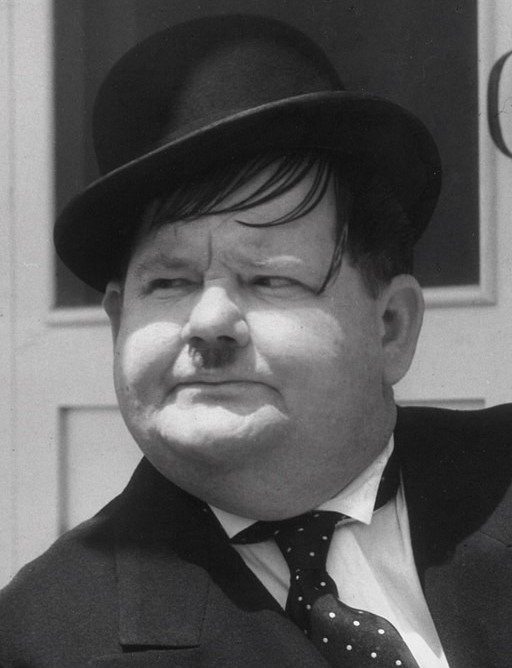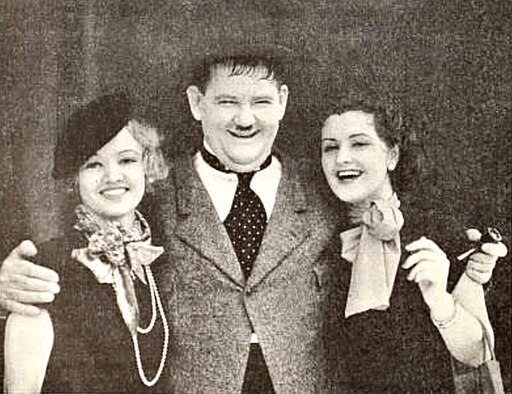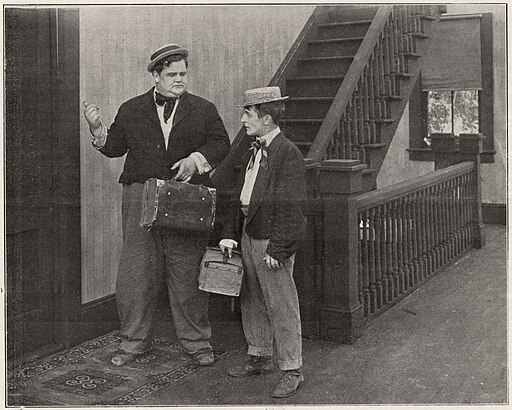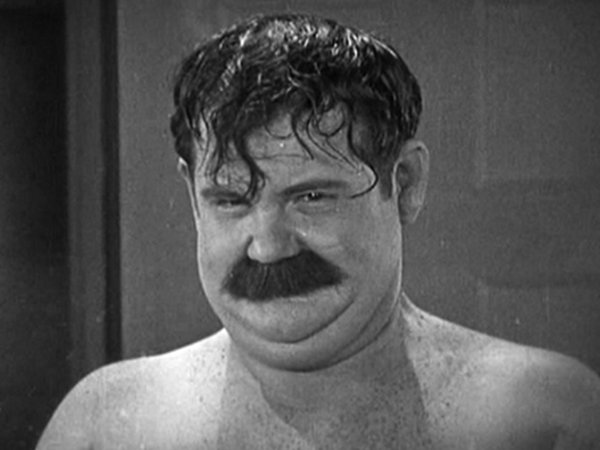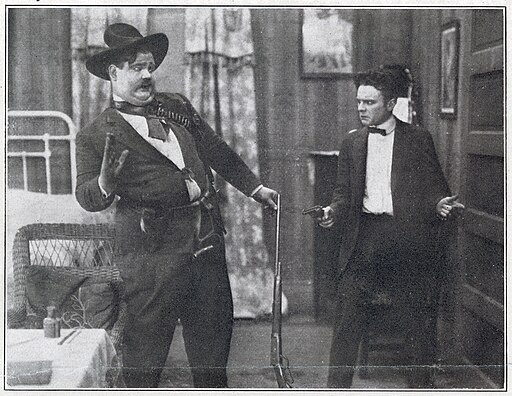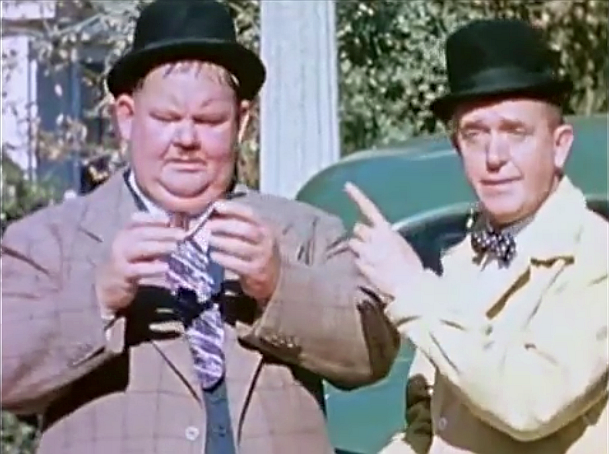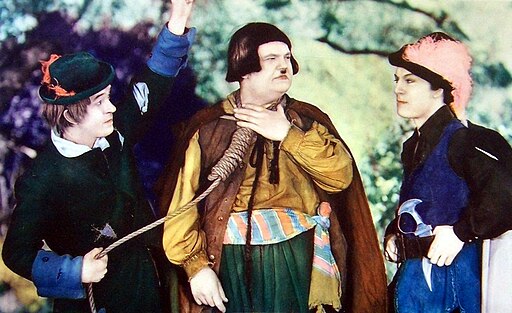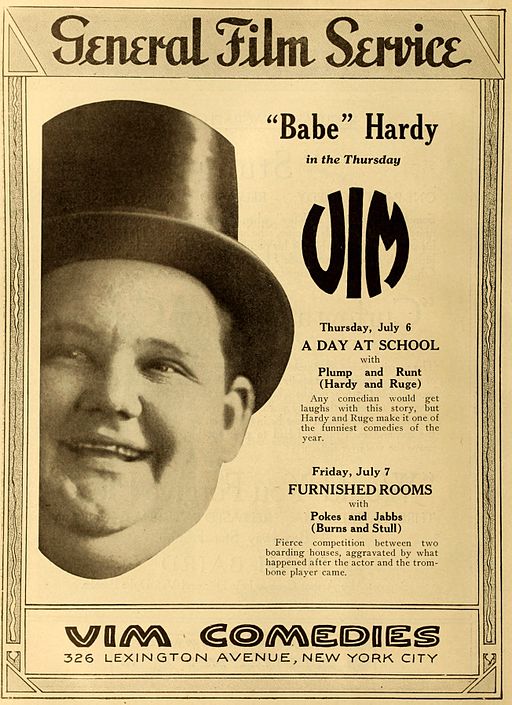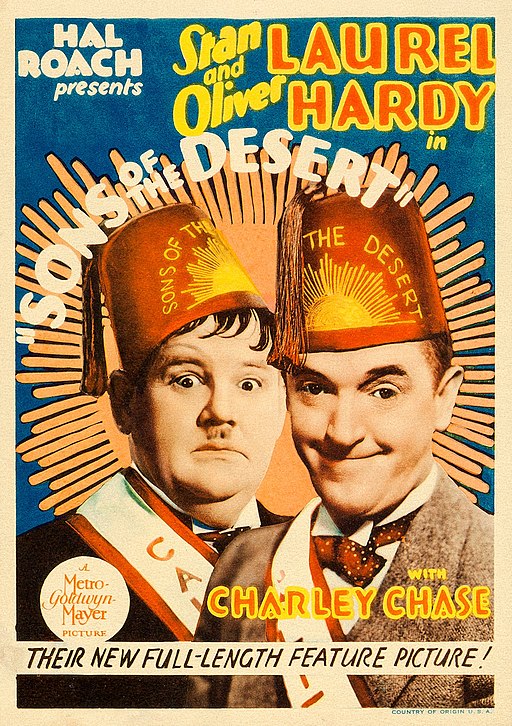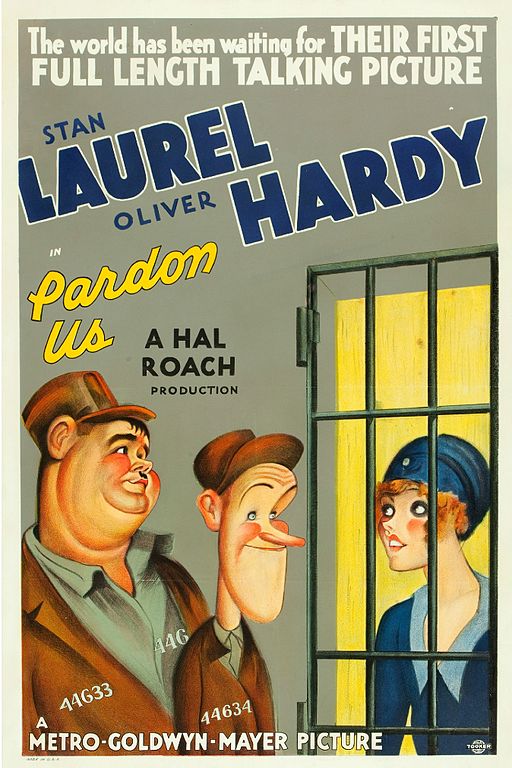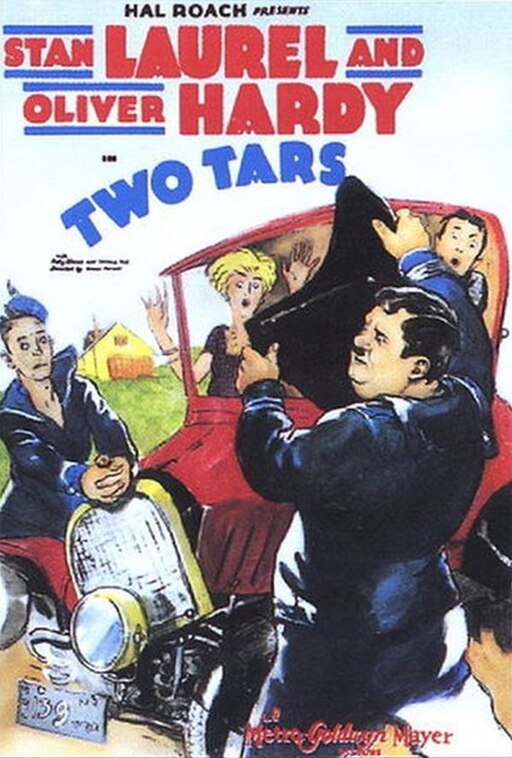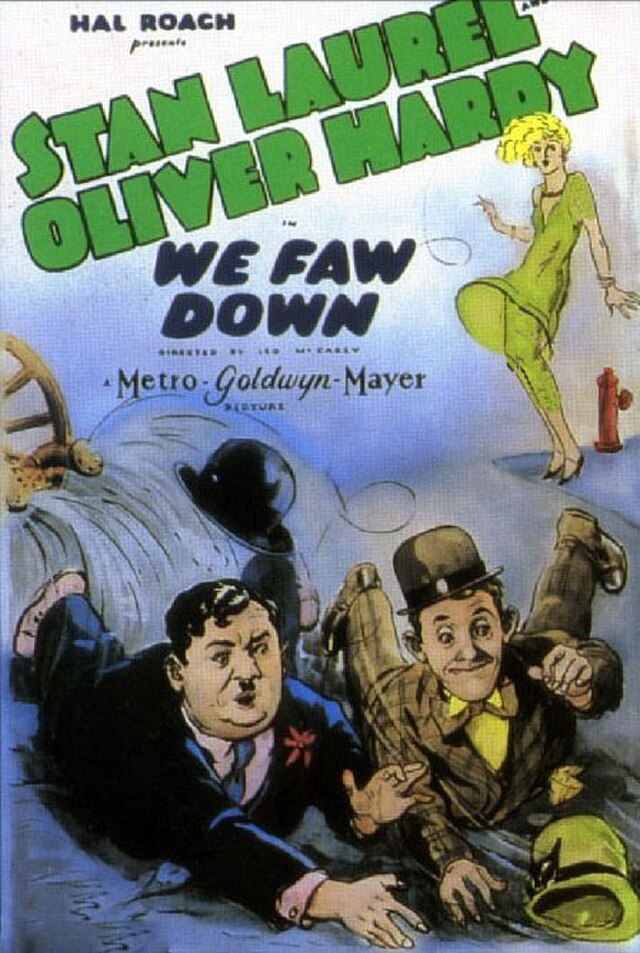Oliver Hardy
back| Full Name | Norvell Hardy |
| Stage Name | Oliver Hardy |
| Born | January 18, 1892 |
| Birthplace | Harlem, Georgia, USA |
| Died | August 7, 1957 |
| Buried | Valhalla Memorial Park Cemetery, North Hollywood, California, USA |
| Married to | Madelyn Saloshin (1913–1921) - Myrtle Reeves (1921–1937) - Virginia Lucille Jones (1940–1957, his death) |
| Children | None |
| Notable films | The Music Box (1932) - Sons of the Desert (1933) - Way Out West (1937) - Babes in Toylamnd (1934) - Pardon Us (1931) |
Oliver Hardy
“Babe” Hardy, King Of Comic Frustration
Oliver Hardy, born Norvell Hardy, was a celebrated American comedian and actor, best known for his part in the comedy duo Laurel and Hardy. His stage name, Oliver Hardy, became iconic in the world of comedy.
Hardy was born on January 18, 1892, in Harlem, Georgia. He developed an early interest in music and theatre, which eventually led to his career in film. Before his famous pairing with Stan Laurel, Hardy worked in more than 250 silent films starting in 1914.
Hardy's career took a significant turn when he teamed up with Stan Laurel. Together, Laurel and Hardy became one of the most famous and beloved comedy duos of all time. Their films typically featured slapstick comedy and were marked by the contrasting personas of the thin, bewildered Stan Laurel and the pompous, overweight Oliver Hardy.
Photo of Oliver Hardy by Harry Warnecke, 1900 - 1984
Related
Oliver Hardy (1892 – 1957)
Biography and Overview of his Career
Oliver Hardy was born as Norvell Hardy on January 18, 1892, in Harlem, Georgia, USA. His early life was marked by a love for music and singing, which would play a significant role in his later career. Hardy was raised in the Southern United States and developed an early interest in theater, often attending shows at the local opera house.
Hardy was a big man from an early age, which contributed to his physical comedic style. Despite his size, he was known for his gentle and kind demeanor. His early attempts to break into show business were in singing and minstrel shows, where he honed his performance skills.
Oliver Hardy's path to success in the film industry began in the silent movie era. He moved to Jacksonville, Florida, then a bustling center for film production, and started his film career in 1914. Hardy worked in more than 250 silent films, often playing the role of the heavy or villain due to his large frame.
His real breakthrough came when he partnered with Stan Laurel. The two were first paired together by producer Hal Roach and soon became famous as the comedy duo "Laurel and Hardy." Their contrasting physical appearances and comedic styles - Laurel being thin and bewildered, Hardy being overweight and pompous - became a formula for success.
Oliver Hardy was affectionately known by a few nicknames throughout his life and career. The most well-known nickname for Hardy was "Babe." This moniker was given to him early in his life, reportedly by an Italian barber who would exclaim "That's my baby!" after finishing Oliver's haircut, and the name stuck with him among his friends and colleagues.
His signature move, a frustrated look into the camera, often communicated more humor and emotion than words could, directly engaging the audience in a shared moment of comic despair.
Marriages Oliver Hardy's personal life, particularly his marital life, was turbulent. He was married three times. His first marriage was to Madelyn Saloshin in 1913, which ended in divorce. He then married Myrtle Reeves in 1921, but this marriage was strained, partly due to Reeves' alcoholism, and ended in divorce in 1937. His final marriage was to Virginia Lucille Jones in 1940, which lasted until his death and was described as harmonious and happy.
Passions and Interests Outside of acting, Hardy had several passions. He was an excellent golfer and an avid fisherman. His love for golf was well-known, and he often played in celebrity golf tournaments. Hardy's gentle nature and love for music continued throughout his life, often singing in his films and in private gatherings.
Death and Legacy Oliver Hardy's health began to decline in the 1950s. He suffered a major stroke in 1956, which left him confined to bed and unable to speak for several months. He suffered two more strokes in early 1957 and passed away from cerebral thrombosis on August 7, 1957, at the age of 65. He was buried at Valhalla Memorial Park Cemetery in North Hollywood, California.
Oliver Hardy's death was deeply felt in the entertainment world, marking the end of one of the most beloved comedy teams in cinema history. His partnership with Stan Laurel had produced over 100 films, leaving a lasting impact on comedy and cinema. Laurel and Hardy continue to be celebrated for their pioneering work in film comedy, remembered for their timeless humor and the joy they brought to audiences worldwide.
Video "Busy Bodies" from 1933 with Oliver Hardy and Stan Laurel:
Analysis of the Acting Style of Oliver Hardy:
Oliver Hardy's acting style was a unique blend of physical comedy, expressive facial reactions, and a refined sense of timing, which made him a standout performer in the era of silent and early sound films. His work, particularly as part of the iconic duo Laurel and Hardy, remains a benchmark in the world of comedy. Here’s a detailed analysis of his acting style:
Physical Comedy
Hardy was a master of physical comedy. His large frame (he was often billed as "Babe" Hardy in his early career due to his size) was used to great comedic effect. He had an uncanny ability to use his body in ways that were both humorous and expressive. This included exaggerated gestures, slapstick falls, and physical mishaps that seemed to happen to him with a perfect blend of timing and humor. Despite his size, Hardy was surprisingly agile, and this contrast between his appearance and his ability to move gracefully added an extra layer of comedy to his performances.
Expressive Facial Reactions
One of the hallmarks of Hardy's acting was his remarkable facial expressiveness. He had the ability to convey a wide range of emotions without saying a word. His reactions often involved raised eyebrows, a dumbfounded look, a frustrated glance at the camera, or a sheepish smile, which became iconic. This technique of breaking the fourth wall and looking directly into the camera became a signature of Laurel and Hardy films, creating a unique connection with the audience.
Vocal Delivery and Timing
With the advent of sound in cinema, Hardy's vocal talents became more prominent. He had a rich, deep voice that contrasted amusingly with his on-screen partner Stan Laurel's higher-pitched, British tone. Hardy's timing in delivering lines was impeccable, often using pauses and inflection to enhance the humor. His famous catchphrase, "Well, here's another nice mess you've gotten me into," delivered with a mix of exasperation and resignation, is a classic example of his expert timing and vocal expression.
Chemistry with Stan Laurel
Hardy's acting cannot be fully appreciated without considering his chemistry with Stan Laurel. They complemented each other perfectly, with Laurel playing the childlike, naive character to Hardy's more pompous, yet equally inept persona. This dynamic allowed Hardy to play both the straight man and the comic, reacting to Laurel's antics with a mix of frustration, bewilderment, and paternal affection.
Subtlety and Nuance
Despite often engaging in slapstick, Hardy's performances were marked by subtlety and nuance. He had the ability to convey a depth of character and emotion even in the most outrageous comedic scenarios. His performances were not just about making people laugh; they often contained a human element that made his character relatable and endearing.
Influence and Legacy
Oliver Hardy's acting style had a significant influence on the genre of comedy. His blend of physical humor, expressive facial reactions, and impeccable timing set a standard for comedic performances. The legacy of his work, especially in collaboration with Stan Laurel, continues to influence comedians and actors in both technique and the art of forming a comedic duo.
Last Footage of Stan Laurel and Oliver Hardy from 1956:
Memorable Quotes from Oliver Hardy:
Oliver Hardy, known for his comedic genius and memorable on-screen persona, especially as part of the Laurel and Hardy duo, delivered many memorable lines throughout his career. These quotes, often delivered in the midst of humorous and challenging situations, became synonymous with the duo's style of comedy. Here are some of the most memorable quotes attributed to Oliver Hardy:
"Well, here's another nice mess you've gotten me into!"
- This is perhaps the most famous line associated with Oliver Hardy. It was often directed at his on-screen partner, Stan Laurel, usually after finding themselves in a comical and often self-inflicted predicament.
"Why don't you do something to help me?"
- This line typically came up in situations where Laurel and Hardy were in trouble, and Hardy's character would be frustrated with Laurel's lack of useful assistance.
"This is no time for levity."
- Hardy would often say this in situations that were ironically the product of their own comic misadventures, highlighting the absurdity of their circumstances.
"I'm Mr. Hardy, and this is my friend, Mr. Laurel."
- A common introductory line, emphasizing the duo's partnership and often setting the stage for the comedic interactions that would follow.
"Isn't that nice?"
- Typically delivered in a sarcastic tone, especially when something unfortunate happened or when encountering something that was less than 'nice.'
"That's another fine mess you've gotten us into."
- A variation of his most famous line, expressing exasperation at their latest comedic predicament.
"I’ve had enough of this."
- Usually uttered in a moment of frustration, often just before the situation would escalate to even more comedic heights.
"Tell me that again."
- Often used when Hardy needed clarification on a particularly confusing statement or plan from Laurel, usually highlighting the silliness of their situation.
Trivia:
A] The Grave of Oliver Hardy:
Oliver Hardy, the renowned comedian and one half of the famous Laurel and Hardy duo, is buried at the Valhalla Memorial Park Cemetery in North Hollywood, California. His final resting place is significant not just as a site of remembrance for his fans, but also as a symbol of the enduring legacy he left in the world of comedy and cinema. Here are some details about his grave and the memorial:
Location
- Cemetery: Valhalla Memorial Park Cemetery
- Address: 10621 Victory Boulevard, North Hollywood, California, USA
The Grave Site
- Interment: Oliver Hardy was laid to rest in the Masonic Garden, a section of the Valhalla Memorial Park. The Masonic Garden is an area reserved for members of the Freemasonry fraternity, which Hardy was a member of.
- Grave Marker: The grave of Oliver Hardy is marked with a simple headstone. In keeping with the modest and unassuming nature of many graves of that era, it bears his name and lifespan: "Oliver Hardy 1892–1957."
Visitation
- Public Access: The cemetery is accessible to the public, allowing fans and admirers of Oliver Hardy to visit and pay their respects. It has become a place for many to remember not only Hardy but also the joy and laughter he brought to countless people through his films.
- Fans and Admirers: Over the years, fans of Laurel and Hardy have paid tribute to Oliver Hardy at his grave site. These tributes often include flowers, notes, and sometimes memorabilia related to their films.
B] Weight Loss of Oliver Hardy:
Oliver Hardy, known for his large frame which was a significant part of his comedic persona, did experience a considerable weight loss towards the end of his life. This change was not due to a lifestyle choice or a health regimen, but rather was a result of illness.
Late-Life Illness and Weight Loss
- Illness: In the early 1950s, Oliver Hardy suffered a series of strokes. These strokes significantly impacted his health, leading to a noticeable decline in his physical condition.
- Weight Loss: As a result of his illness, Hardy lost a substantial amount of weight. This change was so pronounced that when photos of him during this time were made public, fans were often shocked at his appearance, as it was drastically different from the robust figure they were accustomed to seeing on screen.
- Impact on Career: Hardy's health issues and subsequent weight loss affected his ability to work. The Laurel and Hardy duo ceased performing together as Hardy's condition worsened.
- Public Perception: To many fans and observers, Oliver Hardy's weight was a part of his identity, especially as part of the Laurel and Hardy duo. His loss of weight, therefore, was a visual indicator of his declining health and was met with concern and sadness by those who had enjoyed his work.
Awards and Recognition:
- Academy Awards: Laurel and Hardy's film "The Music Box" (1932) won an Academy Award for Best Live Action Short Film. This short film is one of their most famous works, known for the iconic scene of the duo attempting to move a piano up a long flight of outdoor steps.
- Venice Film Festival: In 1932, Laurel and Hardy were awarded a Special Recommendation at the Venice Film Festival for their contributions to comedy.
Posthumous Recognitions
After his death, Oliver Hardy, along with Stan Laurel, received more recognition for their work:
- Star on the Hollywood Walk of Fame: Laurel and Hardy were jointly awarded a star on the Hollywood Walk of Fame on February 8, 1960. Their star is located at 1500 Vine Street.
- Legacy and Tributes: Various film festivals, organizations, and entities in the film industry have acknowledged and celebrated the work of Laurel and Hardy, often honoring them posthumously for their contributions to the art of film comedy.
It's important to note that during Hardy's lifetime, the film industry's recognition of artists was quite different than it is today. Short films and comedy acts were not as heavily awarded as feature films and dramatic performances. Despite this, the legacy of Oliver Hardy, particularly in partnership with Stan Laurel, is monumental in the history of cinema.
Movies featuring Oliver Hardy:
Pre-Laurel and Hardy (1914–1926)
- 1914: "Outwitting Dad," "Casey's Birthday," "The Serenade," "The Female Cop," "The Daddy of Them All," "He Won a Ranch," "The Particular Cowboys," "The Kidnapped Bride," "An Expensive Visit," "His Sudden Recovery"
- 1915: "The Prize Baby," "Mixed Flats," "Who Stole the Doggies?" ... [and many more]
- 1916-1926: [Numerous titles across these years, including "The Millionaire," "Mother's Baby Boy," "The Candy Trail," "The Jolly Jilter," "The Nuisance," "Hop to It!," "The Stolen Jools," etc.]
Laurel and Hardy Era (1926–1945)
- 1926: "45 Minutes from Hollywood"
- 1927: "Duck Soup," "Slipping Wives," "Love 'Em and Weep," "Why Girls Love Sailors," "With Love and Hisses," "Sugar Daddies," "Sailors, Beware!," "The Second Hundred Years," "Now I'll Tell One," "Call of the Cuckoo," "Hats Off," "Do Detectives Think?," "Putting Pants on Philip"
- 1928: "The Battle of the Century," "Leave 'Em Laughing," "Flying Elephants," "The Finishing Touch," "From Soup to Nuts," "You're Darn Tootin'," "Their Purple Moment," "Should Married Men Go Home?," "Early to Bed," "Two Tars," "Habeas Corpus," "We Faw Down"
- 1929: "Liberty," "Wrong Again," "That's My Wife," "Big Business," "Unaccustomed As We Are," "Double Whoopee," "Berth Marks," "Men O'War," "Perfect Day," "They Go Boom!," "Bacon Grabbers," "The Hoose-Gow," "Angora Love"
- 1930: "Night Owls," "Blotto," "Brats," "Below Zero," "Hog Wild," "The Laurel-Hardy Murder Case," "Another Fine Mess"
- 1931: "Be Big!," "Chickens Come Home," "Laughing Gravy," "Our Wife," "Come Clean," "One Good Turn," "Beau Hunks"
- 1932: "Helpmates," "Any Old Port!," "The Music Box," "The Chimp," "County Hospital," "Scram!," "Their First Mistake"
- 1933: "Towed in a Hole," "Twice Two," "Me and My Pal," "The Midnight Patrol," "Busy Bodies," "Dirty Work," "Oliver the Eighth," "Sons of the Desert"
- 1934: "Going Bye-Bye!," "Them Thar Hills," "The Live Ghost," "Babes in Toyland," "Tit for Tat," "The Fixer Uppers"
- 1935: "Thicker than Water"
- 1936: "The Bohemian Girl," "Our Relations"
- 1937: "Way Out West," "Pick a Star," "Swiss Miss"
- 1938: "Block-Heads," "The Flying Deuces"
- 1939: "The Flying Deuces," "A Chump at Oxford"
- 1940: "Saps at Sea"
- 1941: "Great Guns"
- 1942: "A-Haunting We Will Go"
- 1943: "Air Raid Wardens," "Jitterbugs," "The Dancing Masters"
- 1944: "The Big Noise"
- 1945: "Nothing But Trouble"
Post Laurel and Hardy (1949–1951)
- 1949: "Zenobia"
- 1950: "Riding High"
- 1951: "Atoll K" (also known as "Utopia")

